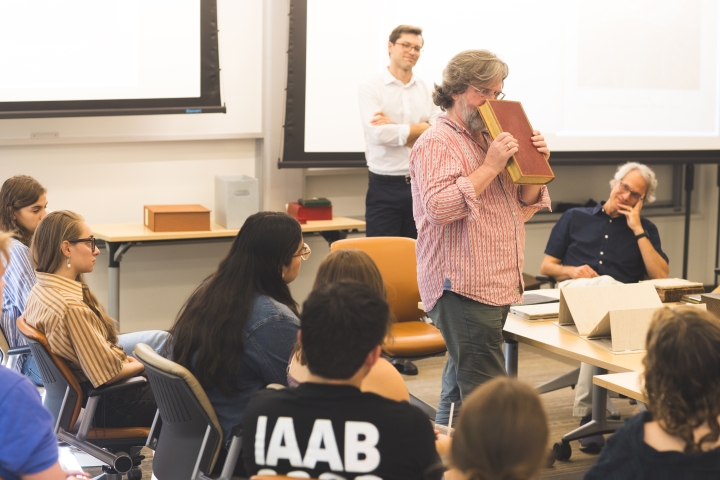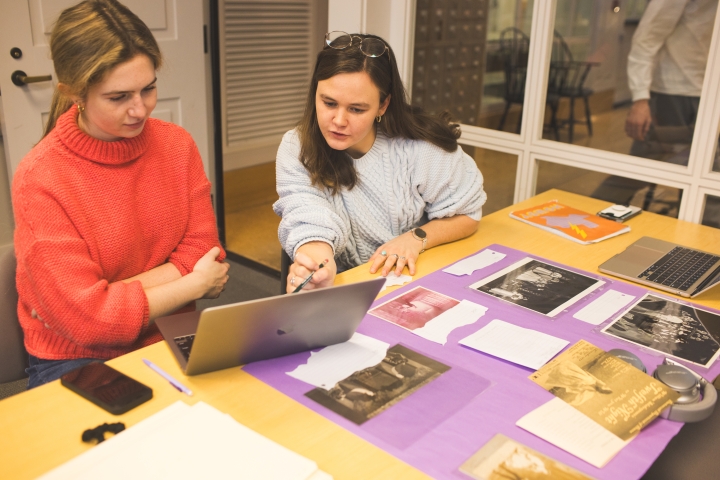Students taking English 15: Shakespeare with Matthew Ritger this fall dove into their final projects, research that would comprise an exhibit celebrating the 400th anniversary of the First Folio—the first published collection of William Shakespeare’s plays, one of which makes its home in the Dartmouth Library’s Rauner Special Collections Library.
“The Whirligig of Time”: Shakespeare in the College Archive, 1623-2023, will be displayed on the second floor of Rauner through mid-March. The title, created by students, includes a phrase from Twelfth Night.
On a cool Thursday morning last month, Ritger’s students gathered in Rauner around tables laden with photographs, professors’ lecture notes, reviews of campus productions, and books, including Dartmouth’s copy of the First Folio, which rested in a custom-made cradle to protect the book’s spine from wear and tear.
Morgan Swan, special collections librarian for teaching and scholarly engagement, explained how to search the catalog and write citations, and encouraged the class to dig into the materials, which represent “just a taste of what we have on Shakespeare.”
“See what you can find,” he told the students, who were working in groups. “Get involved.”
Digging Into Shakespeare
Settling in with a 1681 adaptation of King Lear written by Restoration poet and playwright Nahum Tate, Carolyn Shepard ’27 marveled at how Tate’s version differed from the folio.
“It’s really very interesting because the entire ending is completely changed,” said Shepard, noting that the class had recently read Shakespeare’s Lear. “Cordelia does not die in the end because they wanted it to be a happy ending.”
Nearby, members of her group paged through other early modern texts, including the First Folio, one of just 235 known surviving copies. To ensure ongoing access to the popular text, the folio itself is not included in the exhibit.
“Dartmouth is extremely lucky to have one of these books,” said Ritger, an assistant professor in the Department of English and Creative Writing. “And our students are very lucky to have a collection so open to their use.”
The folio was part of a bequest by the collector Allerton Hickmott, Class of 1917, and his wife, Madelyn. Rauner’s second most requested item after The Book of Mormon, the volume attracts scholars from Dartmouth and far beyond.
Earlier in the fall, the class met with Greg Doran, director emeritus of the Royal Shakespeare Company, on his world tour to see as many of the surviving books as possible.

Doran’s visit was an opportunity for students to see both the folio “and how a charismatic dramaturge and scholar” interacts with it, Ritger said. It also included a talk by Jay Satterfield, head of special collections, about Dartmouth’s copy.
Historic material
Dartmouth’s collection, which is “both world-class and entirely unique,” includes materials that encompass the “whole spectrum of everything that Shakespeare can mean,” Ritger said. “From ephemera, playbills, and set and costume designs to books from the 17th century, quartos, and folios, some of that is material whose learning potential is really only activated in person.”
While exploring the archives at Rauner, the students developed research topics and selected objects that addressed them. Some also visited the Book Arts Workshop to create posters for the exhibit.
Dulce Silva ’25 called the experience “amazing.”
Having direct access to the First Folio and other rare and unique books, manuscripts, photos, and images is “such an honor,” said Silva, an English major with concentrations in creative writing and theater. And interacting with the materials enabled the class to have “important conversations and depict our own thoughts.”
A display of Hickmott’s items was a big draw for students, who took special interest in his scrapbooks, as was the collection of Errol Hill, the first Black professor at Dartmouth to receive tenure.

The Rauner exhibit showcases research from each of the student groups, organized by theme: gender, change over time, and race. It includes materials chosen by Silva, Shepard, and four other students, who explored how Shakespeare’s women characters have been portrayed in Dartmouth productions, and how women actors playing them were received.
Another group’s selections highlight the long history of Black actors in Shakespeare productions, and related controversies, based in large part on Hill’s book Shakespeare in Sable.
Having read the book, and articles citing Hill’s “huge influence” on the study of Black theater, “I see myself as part of this dialogue now,” said English major Scott Sorensen ’26.
The class will reunite in January at a party celebrating the exhibit.
